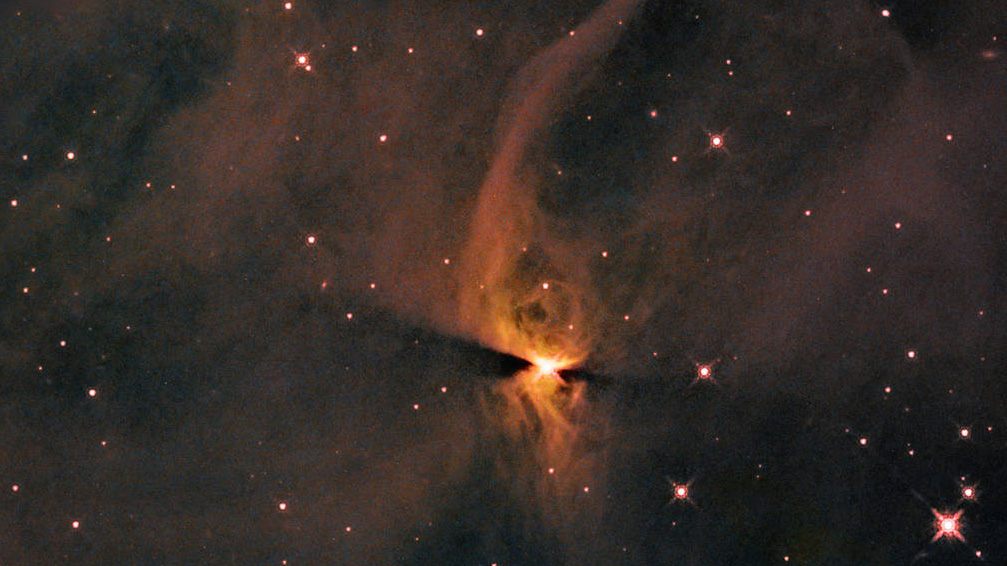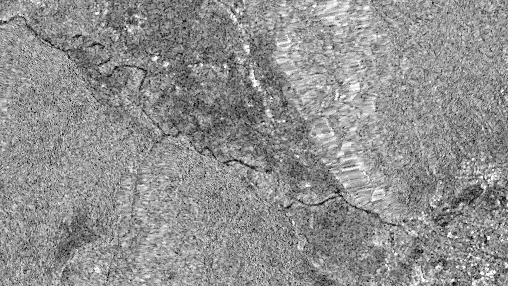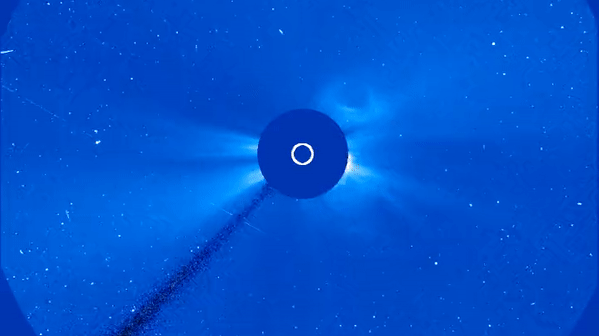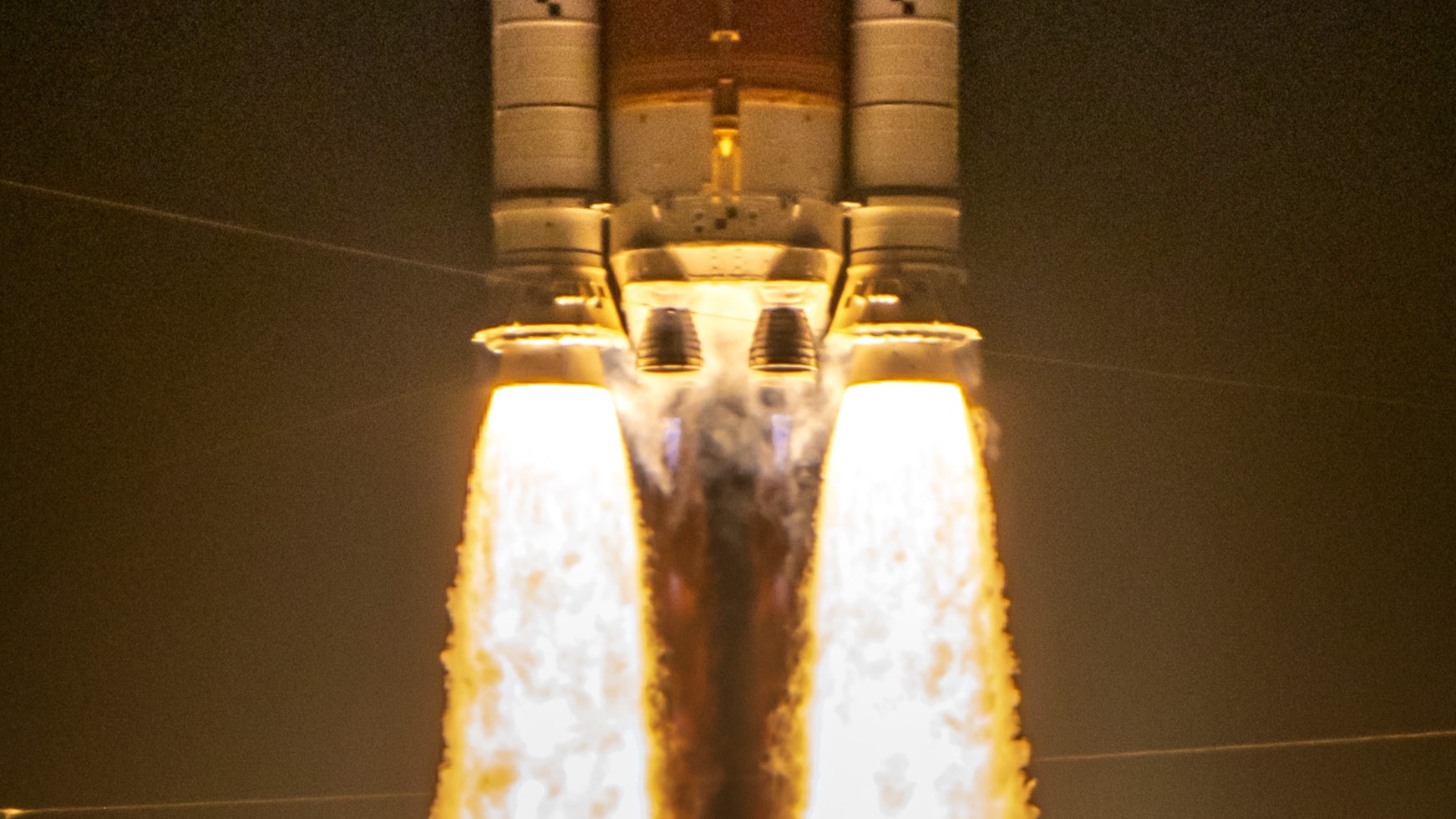November 2021
Satellites observe how La Palma volcano changes the island's shape

Tuesday: November 30, 2021: The volcanic eruption on the La Palma island continues spewing lava more than two months after it started, causing changes to the island's coast that are visible from space.
In this video, which consists of images captured by the European Sentinel 1 satellite between Sept. 14 and Nov. 27, the flows of lava spilling from the Cumbre Vieja volcano can be seen spilling into the ocean at popular tourist beaches, creating new peninsulas.
According to the latest news report, new lava rivers burst out of the fiery crater over the weekend, threatening further destruction. Since the beginning of the eruption, the lava streams have already buried nearly 2,800 buildings and 1,148 hectares of land. -- Tereza Pultarova
Mesmerizing nebula around dying star revealed in new Hubble image

Monday: November 29, 2021: The Hubble Space Telescope captured a new image of a nebula with a fast-expanding halo surrounding a dying star.
The nebula, called NGC 689, is part of the constellation Dolphin, which is located close to the celestial equator in the northern hemisphere.
Astronomers estimate that the outer shell of the halo surrounding the nebula is about 28,000 years old, while the inner shell is only 4,800 years old. These different layers suggest the star at the center of this nebula died in several violent outbursts before collapsing into the dim white dwarf it is today.
The image also reveals the finer structure of the nebula including filaments and knots surrounding the star. -- Tereza Pultarova
Get the Space.com Newsletter
Breaking space news, the latest updates on rocket launches, skywatching events and more!
Space Station Thanksgiving dinner looks like camping lunch

Friday: November 26, 2021: Astronauts at the International Space Station enjoyed a Thanksgiving dinner that may have seemed a bit underwhelming, at least based on images shared by European astronaut Matthias Mauer on Twitter.
In the pictures, members of the current space station crew can be seen tucking into all sorts of canned lunch meats and packaged foods. The dishes float around in a rather messy way, including ketchup and mayonnaise, and fresh fruits such as apples and oranges.
While mainly an American celebration, at the space station, astronauts of other nationalities joined in including Russian cosmonauts Pyotr Dubrov and Anton Shkaplerov.
"One of the best things about international collaboration? Sharing international celebrations and culture," Mauer said in the tweet. "I'm thankful for all my crewmates up here on the Space Station and everyone supporting our mission from Earth." -- Tereza Pultarova
Milky Way and its dwarf neighbors have only just met, study suggests

Thursday: November 25, 2021: Our galaxy, the Milky Way, can be seen in this image surrounded by a group of dwarf galaxies that according to a new study are passing by for the first time.
Previously, astronomers believed these galaxies, about 50, have been orbiting the much larger Milky Way for billions of years. A new analysis of data from the European Space Agency's Gaia mission now revealed that the majority of those dwarf galaxies are newcomers in the Milky Way's neighborhood. Scientists will now have to rethink the evolution of the Milky Way, ESA said in a statement, as well as the chemical composition and nature of these small galaxies. -- Tereza Pultarova
DART's asteroid-deflecting mission begins

Wednesday: November 24, 2021: The asteroid-smasher DART can be seen in this image separating from SpaceX's Falcon 9 rocket which launched it on its one-year journey towards its target asteroid Didymos on Tuesday (Nov. 23).
DART, or Double Asteroid Redirection Test, will smash into a small asteroid called Dimorphos which orbits the larger space rock Didymos next year. The goal of this self-destructive encounter is to change the orbit of Dimorphos around Didymos. The experiment is designed to prove that such an operation can possibly protect Earth from a collision with a space rock. -- Tereza Pultarova
Asteroid deflector ready to go

Tuesday: November 23, 2021: NASA's Double Asteroid Redirection Test spacecraft (DART) is sitting atop SpaceX Falcon 9 rocket at Vandenberg Space Force Base, ready to commence its ground-breaking asteroid-deflection mission.
DART will take one year to reach a binary asteroid called Didymos and its moon Dimorphos, which is the ultimate target of DART's self-destruction mission. DART will ram into Dimorphos at full speed in an attempt to change its orbit around Didymos. The experiment will verify whether humankind can potentially deflect an asteroid on a collision course with Earth. -- Tereza Pultarova
Star-forming nebula glows in Hubble Space Telescope image

Monday: November 22, 2021: The Hubble Space Telescope captured this image of the Flame Nebula some 1,400 light years away from Earth during its search for brown dwarfs, mysterious objects scattered through the universe that are too dim to be called stars but too bright to be called planets.
The Flame Nebula is part of the Orion Molecular Cloud Complex, a known star-forming region in the constellation Orion. Scientists know that hidden in the cloud of thick dust at the heart of this nebula is a star cluster. The nebula absorbs radiation from the triple star Alnitak, the easternmost star in Orion's belt. This radiation ionizes hydrogen gas in the nebula, which then gradually cools, emitting visible light, which can be seen as the glow in this image. -- Tereza Pultarova
Last lunar eclipse of 2021 wows stargazers in America

Friday: November 19, 2021: The last lunar eclipse of 2021 and the longest in 600 years has turned the full moon red for observers in North America and other parts of the world today.
This image was captured by astrophotographer Tyler S Leavitt, who observed the celestial spectacle near Las Vegas, Nevada.
"Dodging clouds and haze, caught a few seconds of clear sky," Leavitt said in an email.
The eclipse saw the moon 97% covered by the shadow of Earth, enough to create the reddening effect which is caused by the refraction of light in Earth's atmosphere.
The eclipse lasted a little over 6 hours. The moon first entered the penumbra, the imperfect shadow at the beginning of the alignment between Earth, moon and the sun at 1:02 am EST (6:02 GMT). The spectacle peaked with nearly all of the moon in the planet's deep shadow three hours later. The moon exited Earth's deep shadow shortly before 6 am EST (11 am GMT) and a little over an hour later, the longest partial lunar eclipse in nearly 600 years was over.
Next, the world will enjoy a total lunar eclipse, which will take place in May 2022. It will be best observed from South America and the eastern parts of North America. -- Tereza Pultarova
Hubble spots a new star's birth

Thursday: November 18, 2021: A new star just being born inside a distant cloud of collapsed dust and gas can be seen in this image captured by the Hubble Space Telescope.
The protostar, with a not easy to remember name J1672835.29-763111.64, was spotted in one of the closest active star forming regions to our planet, the Chameleon cloud. This cloud, located in the constellation Chameleon, is visible in the sky from the southern hemisphere.
The protostar is part of a nebula called IC 2631, which reflects light from nearby stars.
The protostar emits light as dust and gas accumulates in the surrounding dust cloud. At a certain moment, the density and temperature of the accumulating material will be sufficient to trigger nuclear fusion, the reaction that sustains the life of stars. The leftover gas and dust can then give rise to planets, asteroids, comets, or remain as dust.
Hubble captured the image as part of a survey targeting 321 protostars previously found by the Spitzer and Herschel infrared telescopes. -- Tereza Pultarova
Satellites watch Canadian town hit by 2021 wildfires swamped by floods

Wednesday: November 17, 2021: A Canadian town that spent weeks on evacuation alert due to this year's summer wildfires has been swamped by floodwater after two days of torrential rain.
The extent of the flooding can be seen in this animation, consisting of before and after images of the area near Merritt, British Columbia, taken by the European Sentinel 1 satellite.
All 7,000 residents of the town, some 125 miles (200 kilometers) northeast from Vancouver, have been evacuated after floodwater from the swelling Coldwater River completely overwhelmed the local wastewater treatment plant. The floods triggered mudslides in some areas, which killed at least one person. -- Tereza Pultarova
Ariane 5 readied for James Webb Space Telescope launch

Tuesday: November 16, 2021: The Ariane 5 rocket that will lift the James Webb Space Telescope, the most powerful space telescope ever built, into orbit next month, is being readied at the European Spaceport in Kourou, French Guiana.
The rocket was raised into a vertical position in the past few days at the spaceport's launch vehicle integration building, awaiting the arrival of the solid rocket boosters that will help it off the ground with its precious 6.8-ton (6.2-tonne) payload.
The launch of the James Webb Space Telescope is scheduled for Dec. 18. After its release from the Ariane 5 fairing, the space observatory will require a month to reach its destination in the sun-Earth Lagrange point 2 (L2) some 940,000 miles (1.5 million kilometers) from Earth. At L2, the gravity of our planet and the sun are in balance, which means the spacecraft will retain a relatively stable position as it looks into the most distant universe. -- Tereza Pultarova
Antarctica's fastest melting glacier dwindles in front of satellite's eyes

Monday: November 15, 2021: The Pine Island Glacier in West Antarctica is captured melting away in this time-lapse video comprising satellite images captured between 2015 and 2021.
The Pine Island Glacier is Antarctica's fastest melting ice sheet and according to researchers has retreated by 11 miles (18 kilometers) over the past 6 years. The Pine Island Glacier alone is responsible for 25% of Antarctica's ice loss, thinning, receding and flowing into the Amundsen Sea at an accelerating pace.
Because the glacier is far away from all existing Antarctic research bases (the nearest one is over 800 miles (1,300 kilometers) away), satellites provide the most convenient way to study its evolution. A recent study found that the glacier's melting has sped up in the past few years due to the melting of a floating ice shelf that helps keep it in place. -- Tereza Pultarova
Satellite images reveal how cities eat up land

Friday: November 12, 2021: Images collected by the US Landsat satellites since 1985 reveal how cities all over the world speedily devour surrounding land.
In this animated image, the Thai capital Bangkok, can be seen spreading farther and farther away from the Chao Phraya River delta on the shores of the Gulf of Thailand.
The images were collected as part of the World Settlement Footprint project, spearheaded by the Google Earth Engine. The visualizations, showing the scale of global urbanization, were revealed during the United Nations Climate Change Conference (COP26) in Glasgow, which is concluding this week.
According to the European Space Agency (ESA), which is part of the project, 55% of the global population currently resides in large cities. The number is expected to rise to 68% by 2050. Rapid urbanization combined with the progressing climate change can lead to problems with air pollution, vulnerability to weather-related disasters and problems with supplies of water, energy and raw materials, the agency said in a statement. -- Tereza Pultarova
A merger of distant galaxies observed by South African radio telescope

Thursday: November 11, 2021: A collision of two distant galaxy clusters taking place millions of light years away from Earth has been captured by the South African MeerKAT radio telescope.
The image spans approximately 10 million light-years and is sprinkled with point-like radio emission from even more distant Milky Way-like galaxies.
The radio image also reveals clouds of gas in the intergalactic space, stirred up as the clusters spin around each other pulled ever closer by their enormous gravitational forces.
The image was obtained as part of a large-scale imaging campaign that surveyed radio emissions from 115 clusters of galaxies. The observations, comprising over 1,000 hours of telescope time, were conducted in the year after MeerKAT's 2018 inauguration.
It took two years and a team of over 40 researchers to convert the raw data into the stunning images that have been presented today in the journal Astronomy & Astrophysics. -- Tereza Pultarova
Crew Dragon departs against coral atoll backdrop

Wednesday: November 10, 2021: The Crew Dragon capsule Endeavour can be seen in this image against a range of Pacific coral islands shortly after its departure from the International Space Station on Monday (Nov.8).
The picture, taken from aboard the orbital outpost, captures the Dragon capsule during a fly-around maneuver, which it performed shortly after detaching from the station's Harmony module. The capsule completed a circle around the station at a distance of 660 feet (200 meters) to allow astronauts to photograph the orbiting laboratory before heading of to Earth.
This was the first complete fly-around performed by any spacecraft since the retirement of NASA's space shuttle in 2011. In October, Russian cosmonauts performed a partial fly-around with the Progress capsule during a relocation maneuver that freed a docking port for another capsule bringing a Russian film crew to the space station.
Inside the Dragon that departed on Monday were American astronauts Shane Kimbrough and Megan McArthur, European Thomas Pesquet and Japan's Akihiko Hoshide. The picture was taken as both, Dragon and the space station, flew 259 miles (417 kilometers) above the Jaluit Atoll in the Marshall Islands. The crew landed safely later that day off the coast of Florida. -- Tereza Pultarova
Thomas Pesquet getting used to gravity after six months in space

Tuesday: November 9, 2021: The European Space Agency (ESA) astronaut Thomas Pesquet after exiting the SpaceX Crew Dragon capsule after splashdown off the coast of Florida on Monday (Nov.8).
Pesquet is seen in this video supported by a medical team as his body adjusts to gravity after 199 days in weightlessness aboard the International Space Station. Astronauts experience widespread changes in their brain and body during spaceflight including bone and muscle loss, some of which take months to reverse.
Immediately after landing, astronauts tend to have problems with balance and movement coordination. According to NASA, these problems usually resolve after three days back on Earth. Pesquet will continue his recovery in Cologne, Germany, the home of ESA's Astronaut Centre (EAC) and German Aerospace Centre's (DLR) ‘Envihab’ research facility, which studies the effects of spaceflight on the human body. -- Tereza Pultarova
Space station crew enjoys most spectacular aurora thanks to cannibal eruption

Monday: November 8, 2021: Astronauts at the International Space Station enjoyed the most spectacular aurora display of their entire mission over the weekend after a massive blast of material from the sun reached our planet.
The sun has been acting out lately, waking up to its new period of activity after years of quietness. This variation is part of the sun's regular 11-year cycle, the little understood ebb and flow of sunspots and solar flares that is next set to peak in 2025.
The latest aurora feast, observable from locations much farther to the south than usual, also delivered a stunning spectacle for the current space station crew.
"We were treated to the strongest auroras of the entire mission, over North America and Canada," European Space Agency's astronaut Thomas Pesquet tweeted with a mesmerizing photo of greenish glow. "Amazing spikes higher than our orbit. Star-struck, and we flew right above the centre of the ring, rapid waves and pulses all over."
The latest aurora display was triggered by a double coronal mass ejection, two bursts of magnetized plasma that the sun blasted out last week within a short period of time. The second outburst, travelling a bit faster than the first one, cannibalized its predecessor on the way, resulting in a much more powerful plasma cloud than originally expected.
Auroras get triggered in Earth's atmosphere when magnetized plasma particles from the sun hit the Earth's magnetic field, creating a temporary magnetic havoc around the planet. -- Tereza Pultarova
Lunar mini-rovers take a test ride in fake moon dust

Friday, November 5, 2021: Miniature autonomous rovers designed to explore the surface of the moon as a team showed how they can handle lunar soil in a recent lab test.
The mini-rovers, part of NASA's project called Cooperative Autonomous Distributed Robotic Exploration (CADRE), are each about the size of a shoe-box. Deployed in large numbers, they can survey the moon in a way that a single large rover cannot achieve.
In a latest set of experiments at the Simulated Lunar Operations lab at the Glenn Research Center in Cleveland, NASA engineers tested how well the rovers' wheels deal with the fine-grained regolith as well as larger rocks that can be found on the surface of the moon.
The rovers might fly to the moon within the next five years as part of NASA's Commercial Lunar Payload Services Initiative. -- Tereza Pultarova
Dried out Turkish lake a portent of a climate change future

Thursday, November 4, 2021: Thousands of stunning flamingos perished this summer after Turkey's second largest lake completely dried out due to climate change-induced drought and excessive water use by farmers.
This image, taken by the European Union's Copernicus Sentinel 2 satellite on Oct. 23 shows Lake Tuz in central Turkey, under normal circumstances one of the world's largest salty lakes. But in this image, there is no water in the lake and what used to be its floor is covered in dried out deposits of salt.
Lake Tuz is a so-called hypersaline lake, a lake with salinity greater than that of the ocean. Such lakes have no outlet that would take incoming water away. They only lose water by evaporation which leads to the gradual salt build-up. The lake normally varies in size depending on the season. But over the past years it has been gradually shrinking.
The current state of the lake threatens populations of water birds, most significantly the greater flamingo, which has a major breeding colony on its shores. -- Tereza Pultarova
New flare from the sun promises another aurora display

Wednesday, November 3, 2021: The sun has fired another powerful burst of plasma towards Earth on Tuesday (Nov. 2), which, scientists say, may trigger another round of spectacular aurora displays.
This latest coronal mass ejection (CME), an eruption of ionised gas and magnetised particles from the sun's outer atmosphere, the corona, follows on a powerful flare from Oct. 28. That flare caused geomagnetic storms in Earth's atmosphere, observable as colorful auroras in northern Europe, Canada and the U.S.
The new coronal mass ejection came from a different sun spot than the one last week, NASA's Solar and Heliospheric Observatory (SOHO) mission said on Twitter. It was this observatory that captured the above video from its vantage point about 900,000 miles (1.5 million kilometers) from Earth.
"And yet another spectacular halo CME directed towards Earth," the SOHO mission said on Twitter. "This one was produced by [active region] AR 12981 near the central meridian and erupted just a few hours after another large CME from [active region] AR 12887. Let's hope that this one will produce more impressive aurorae than the Halloween storm." -- Tereza Pultarova
Extreme weather events are a new normal, such as this storm in Pacific Northwest

Tuesday, November 2, 2021: Extreme weather events are becoming a new normal amid the rapidly progressing climate change, according to the World Meteorological Organization. This time lapse shows one such event: a powerful extratropical storm that hit the Pacific Northwest on Oct. 24 and 25.
The storm, captured here in an animation based on data from the GOES-17 satellite operated by the National Oceanic and Atmospheric Administration, reached central atmospheric pressure equivalent to a category 4 hurricane. According to NASA, the storm was one of the most intense ever to strike the Pacific Northwest, drawing a historic amount of moisture into the region.
In fact, this storm was one of two extreme low pressure storms to hit the area within one week. Both of these storms channelled massive amounts of moisture from Hawaii in what meteorologists call atmospheric rivers.
In Marin County, 16.55 inches (42 centimeters) of rain fell within 48 hours. Downtown San Francisco reported a record-setting 4.02 inches (10 cm) on Oct 24 alone. In Blue Canyon, California, 10.4 inches (26 cm) fell within a 24-hour period.
The downpours triggered flash floods in many areas but also doused the wildfires that are still smoldering in places after this year's extreme fire season. -- Tereza Pultarova
Satellites observe unrelenting progress of climate change

Monday, November 1, 2021: Satellites play a key role in monitoring the Earth's rapidly changing climate. This image, taken in June this year by a European satellite, shows what a record-breaking heatwave in a Canadian town looked like from space.
Today, the United Nations' 2021 Climate Change Conference, also known as COP26, kicked off in the Scottish city of Glasgow with the hope of thwarting the unrelenting progress of global warming, brought about by the previous reluctance of global leaders to take firm and speedy action to curb greenhouse gas emissions.
The Paris Agreement, negotiated at the 2015 Climate Change Conference in the French capital, binds countries to strive to keep the rise of global temperatures below 1.5 degrees Celsius compared to preindustrial times. However, the Emissions Gap Report 21, released by the United Nations Environment Programme (UNEP) last week, shows that current emission reduction pledges are by far not enough to achieve the goal. According to the report, the world is on track to seeing global temperatures jump by 2.7 degrees Celsius by the end of this century.
The world is already getting a glimpse of what out-of-control warming might mean. This year saw a string of weather-related disasters all over the world. The record-breaking heatwave that gripped the American northwest and led to devastating wildfires is only one of them.
This image of the town of Gretna in the Canadian province of Manitoba was taken on June 4, 2021 when local temperatures soared to 106 degrees Fahrenheit (41.3 degrees Celsius). Average temperatures in this region during summer months are around 75 degrees Fahrenheit (24 degrees Celsius). -- Tereza Pultarova
Can't find the date you're looking for? It may have been a weekend or holiday, when we don't normally update our Image of the Day.
Click 'NEXT PAGE' below for December >
Check out our Image of the Day Archives for more awesome photos.
Image of the Day 2023 Archive

Image of the Day 2022 Archive

Image of the Day 2021 Archive

Image of the Day 2020 Archive

Image of the Day 2019 Archive

Join our Space Forums to keep talking space on the latest missions, night sky and more! And if you have a news tip, correction or comment, let us know at: community@space.com.

Space.com is the premier source of space exploration, innovation and astronomy news, chronicling (and celebrating) humanity's ongoing expansion across the final frontier. Originally founded in 1999, Space.com is, and always has been, the passion of writers and editors who are space fans and also trained journalists. Our current news team consists of Editor-in-Chief Tariq Malik; Editor Hanneke Weitering, Senior Space Writer Mike Wall; Senior Writer Meghan Bartels; Senior Writer Chelsea Gohd, Senior Writer Tereza Pultarova and Staff Writer Alexander Cox, focusing on e-commerce. Senior Producer Steve Spaleta oversees our space videos, with Diana Whitcroft as our Social Media Editor.









